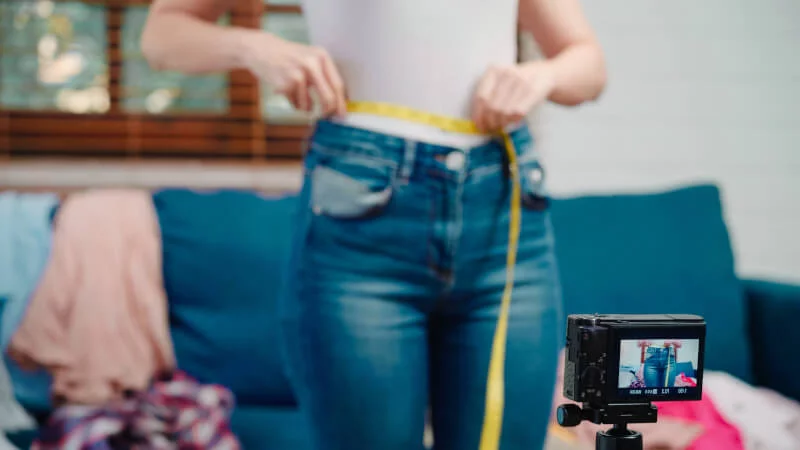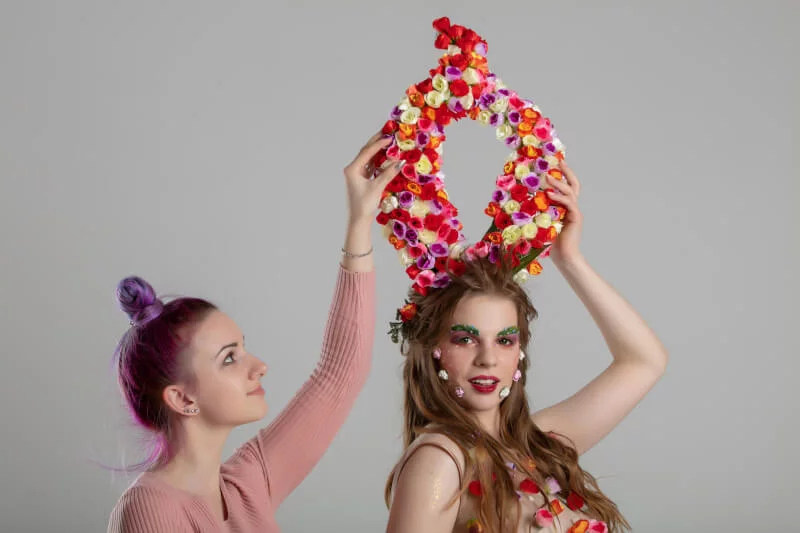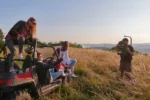Think of your favourite movie moment, whether it’s the hero making an entrance, the romantic lead leaning in for the first kiss, or the villain exposing his or her nefarious strategy. Now picture that same scene sans the characters’ and the setting’s carefully chosen clothing. Quite dissimilar, wouldn’t you say? That’s the power of good styling on a film set.
Whether it’s the 1920s flapper gowns of “The Great Gatsby,” the 1980s uniforms of “Blade Runner,” or the 19th-century garb of “Downton Abbey,” every garment serves an important narrative function. They convey not only the setting but also the characters’ identities, social standings, and feelings.
Styling is an essential component of developing a movie or TV show, and it has more to do with the overall aesthetic than just how the characters are dressed. Your job as a stylist is to make the screenplay come alive through the characters’ clothes and hairstyles. This is a demanding job that calls for initiative, ingenuity, resourcefulness, and, yes, considerable retail expertise. Whether you’re a seasoned stylist in need of some inspiration or a complete newcomer to the field of costume design, you’ll find some helpful advice in this piece. Learn the secrets of making memorable characters with costume design by reading on!
Stylist’s Function in Bringing the Script and Characters to Life

Your job involves more than just picking out fashionable outfits; it’s also about communicating ideas through the presentation. Your role as a stylist gives you the exciting opportunity to play a direct role in telling the tale through the characters’ looks. What your characters wear can reveal a lot about who they are and where they come from socioeconomically, professionally, geographically, and emotionally.
Consider tailored suits and high-end accessories for a character who is a powerful lawyer, for instance. Perhaps ripped jeans and band tees are more suitable for a rebellious adolescent. The clothes a character wears can reveal a lot about who they are and where they come from.
Clothing Decisions Based on the Script
The script is like a road map, full of information and hints about the plot and the characters. Pay close attention to the character descriptions, especially those that include details on the attire and accessories the characters are wearing. These specifics will shed light on the personalities of the characters and provide direction for developing a visual language that complements the intentions of the script’s author.
As an illustration, Miranda Priestly’s high-end and fashionable clothes in “The Devil Wears Prada” is sharply contrasted with Andy Sachs’s initially unattractive and uninspiring attire. This contrast aids in graphically conveying their divergent perspectives on fashion and their respective standings within the high-fashion magazine industry.
Your stylistic effort will have a firm foundation in your familiarity with the storyline and the characters. At this point, you may get down to the nitty-gritty of the production, dealing with things like finding, fitting, and maintaining the costumes.
Studying and Inspiration
Production set styling that is both excellent and authentic requires much preparation, including extensive study. The stylist’s job is more than just cosmetic; they must also ensure that the characters’ clothes are appropriate for the setting, era, culture, and other details of the screenplay.
The Necessity of Extensive Study for the Development of Authentic and Appropriate Designs
The clothes and accessories must be researched thoroughly to match the nuances of the script. It would be a huge faux pas, for instance, to utilise fashions that didn’t become popular until the 1950s in a film set in the 1920s. The same holds for ensuring that a character’s clothing accurately represents their ethnic heritage. In this regard, resources such as Pinterest and Instagram can complement traditional resources like libraries and museums.
Periods, Cultures, Current Fashion, and Other Sources of Styling Inspiration
There are several potential origins for fashion-related inspiration. The fashions and trends of bygone eras can provide a wealth of material that can be reimagined for a contemporary audience. In addition, there is a wealth of unique and fascinating fashion ideas to be gleaned from the world’s myriad cultural traditions.
Stylists often find inspiration in both current and historic fashion trends. Keep in mind that as a reflection of societal values, customs, and changes, fashion may give your story and its characters an extra layer of nuance and interest.
Inspiration can also be found in works of art. Artistic creations such as paintings, sculptures, and buildings might inspire novel looks for the characters.
The ultimate objective is to completely submerge yourself in a universe of visual imagery and thoughts that are consistent with the world of your characters. Doing your homework will allow you to develop unique aesthetics for your characters and stories that will impress readers and listeners.
Making a Style Guide
A production style guide is a vital resource for all those involved in the making of the film, not just the stylists. It helps maintain uniformity and realise a unified vision for the film’s or show’s characters and plot. Having a unified style guide can help the team communicate more effectively and make decisions that are consistent with the personalities of the characters and the needs of the story.
Why You Should Make a Style Guide
The establishment of clarity and uniformity in design choices can be aided by the creation of a style guide. The time saved and the potential for misunderstandings that could lead to mistakes are both reduced as a result. This manual serves as a reference for all parties involved, making it simpler to realise the intended aesthetic for each personality.
In addition, a style guide is an ever-evolving document that can be modified as the screenplay develops, guaranteeing that the visual portrayal of characters is consistent throughout the process.
Important Parts of a Style Guide
All characters should have standards, as well as visual references and descriptions. Some crucial components could be:
Descriptions of the Characters
Outline the history, personality, and function of each major character in the plot to get things rolling.
Instructions for Attire
Specifics on the clothes, colours, and accessories that each character typically wears. This may also offer suggestions about what to wear in certain situations or eras.
Aesthetic Preparation
Included are visual depictions and written descriptions of each character’s distinctive hair and cosmetics styles.
Images to Inspire You
Be sure to include images that reflect each character’s flair. Images from fashion publications or historical archives could also qualify. Notes about the story’s locale, historical period, and cultural influences that could inform aesthetic choices would be helpful.
Pre-production isn’t complete without a style guide, which lays the groundwork for a consistent and effective styling process that will bring characters to life in a way that enhances the story.
Fitting

The fitting procedure is essential to the styling process since it ensures that the clothing chosen for each character not only fits the character and the actor but also functions well during the shoot. In these sessions, the stylist’s concepts are implemented and the final touches are made, bringing the characters to life.
Why Proper Sizing Is So Crucial
When it comes to the realm of production, nothing is more important than the fine-tuning of the outfits. Stylists can ensure the performers’ comfort and freedom of movement by taking measurements during fitting sessions. After all, if an actor is wearing a costume that doesn’t fit, it will take the audience out of the experience.
Fittings also allow for the discovery of any last-minute modifications and tweaks to be made before principal photography begins. They also promote communication between costume designers and actors, who may then discuss the practicality of costumes in the context of individual scenes.
However, during dress rehearsals, the audience can see the production as a whole, from costumes and makeup to sets and lighting. It’s the last chance to fine-tune your character designs and make sure they mesh well with the film’s or show’s overall aesthetic before production begins.
Advice for Organising Productive Fitting Sessions
Planning Is Crucial
Be sure to steam or iron everything before trying it on. In this way, you can get a better idea of how they’ll look on film.
Engage the Talent
Involve the actors in the fitting process by asking for their thoughts. They have unique perspectives on the performance, the character, and the way the garment fits and moves.
For the record, take pictures of each ensemble from a variety of directions. Dress rehearsals and filming days will benefit from having access to these photos for use as continuity references.
Adaptability and Ease of Mobility
The actor’s comfort and freedom of movement on set are just as important as the costume’s aesthetic quality. Always have a little repair kit on hand in case of an emergency. Sewing needles, safety pins, double-sided tape, and other basic supplies can fall into this category.
Handling Clothes-Related Disasters
Although wardrobe malfunctions are never ideal, they are unfortunately common in the entertainment industry. Unexpected problems, such as a torn seam, a broken zipper, or an unseen stain, might affect manufacturing schedules and quality. A professional stylist, however, will always be ready for the unexpected, guaranteeing that any wardrobe malfunctions may be corrected swiftly and easily while on set.
Problems with Your Wardrobe and How to Fix Them
Frayed Hems: Use a safety pin or some fashion tape to make a quick repair. A sewing kit is a good thing to have on hand for a more permanent fix.
Teething Troubles
A safety pin or wardrobe tape could be used as stopgap measures. However, the ability to quickly change zippers and a supply of spares will be important.
Different ways of stain removal may be required, depending on the type of stain. For new stains, use water; for more persistent marks, use a stain remover pen; and for dark garments, use chalk.
Problems with Footwear
New shoes, especially, can cause painful blisters. Bandages and cushions designed for blisters can provide instant relief. Baby powder is a great solution for noisy footwear.
Needed Equipment for Emergency Repairs
The wardrobe department on set cannot function without a stylist’s arsenal. Some necessities include:
- Needles, varied colours of thread, buttons, safety pins, and extra zippers are all essential components of a well-stocked sewing kit.
- Two-sided tape for clothing: A stylist’s best friend, this is useful for keeping garments in place, mending tears, and controlling low-cut necklines.
- A stain pen can be used to quickly and easily get rid of small stains.
- Costumes may be kept wrinkle-free and ready for filming with the use of a steamer and iron.
- Heel caps, cushioned insoles, non-slip pads, and a shoe polish or cleaner comprise the shoe care kit.
- Band-aids, blister pads, and some over-the-counter pain medication are essential items for any basic first-aid kit on set.
Production efficiency and your standing as a competent and trusted stylist both benefit from your ability to foresee and prepare for probable clothing mishaps. All of that goes on behind the scenes to make a show come to life.
How To Overcome Stylist Challenges

As a stylist, you are about to enter a world of innovation and challenge the first time you set foot on a production set. In this fast-paced setting, the stylist is crucial because they use clothing and style to bring the people, their tales, and the overall narrative concept to life. A Stylist becomes a storyteller in their own right when they read scripts, pull from an abundance of inspiration, meticulously plan with style guidelines, ensure a great fit in dress rehearsals, and deftly navigate any wardrobe mishaps.
The stylist’s process begins with a thorough familiarity with the screenplay and the characters, which serve as the inspiration for the stylist’s work. The stylist then conducts extensive study, drawing ideas from a wide range of sources including past eras, other civilizations, and contemporary fashion. The stylist takes these considerations into account when developing a style guide, which serves as a road map for ensuring that the production’s aesthetic goals are met.
When it comes to the nuts and bolts of styling, fittings and dress rehearsals are indispensable. In addition to making sure the costumes are a proper fit, these sessions also provide the performers a chance to get comfortable in their costumes and get into character.
Finally, you’ll need a healthy dose of agility, inventiveness, and foresight to deal with wardrobe malfunctions. A stylist’s ability to keep the production going smoothly and the integrity of the costume design are intact depends on his or her access to crucial tools and readiness to deal with regular wardrobe disasters.
- A Chat with Nate and Mika, Christian Wedding Photographers - July 18, 2024
- Ultimate Guide To Playing Online Casinos - May 27, 2024
- Addiction Recovery Books Worth Reading - January 24, 2024





